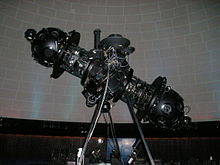





A Zeiss projector is one of a line of planetarium projectors manufactured by the Carl Zeiss Company. Main models include Copernican (1924), Model I (1925), Model II (1926), Model III (1957), Model IV (1957), Model V (1965), Model VI (1968), Spacemaster (1970), Cosmorana (1984), Skymaster ZKP2 (1977), and Skymaster ZKP3 (1993).[1]
The first modern planetarium projectors were designed and built in 1924 by the Zeiss Works of Jena, Germany.[2] Zeiss projectors are designed to sit in the middle of a dark, dome-covered room and project an accurate image of the stars and other astronomical objects on the dome. They are generally large, complicated, and imposing machines.
The first Zeiss Mark I projector (the first planetarium projector in the world) was installed in the Deutsches Museum in Munich in August, 1923.[3] It possessed a distinctive appearance, with a single sphere of projection lenses supported above a large, angled "planet cage". Marks II through VI were similar in appearance, using two spheres of star projectors separated along a central axis that contained projectors for the planets. Beginning with Mark VII, the central axis was eliminated and the two spheres were merged into a single, egg-shaped projection unit.
- ^ "Planetarium history". ZEISS Group. Retrieved 13 May 2022.
- ^ Christopher Dewdney. Acquainted with the Night: Excursions Through the World After Dark. Bloomsbury Publishing USA; 2005 [cited 14 October 2011]. ISBN 978-1-58234-599-4. p. 278–279.
- ^ Mark R. Chartrand. "A Fifty Year Anniversary of a Two Thousand Year Dream – The History of the Planetarium". Retrieved 5 September 2012.